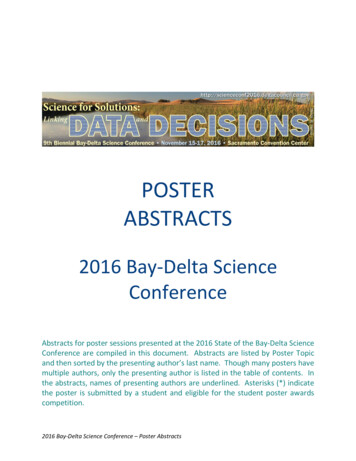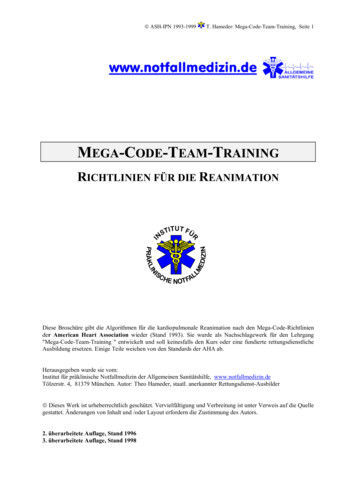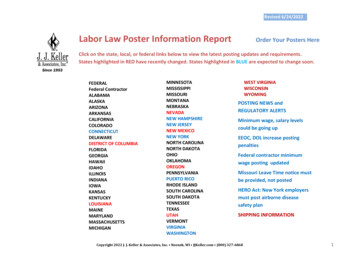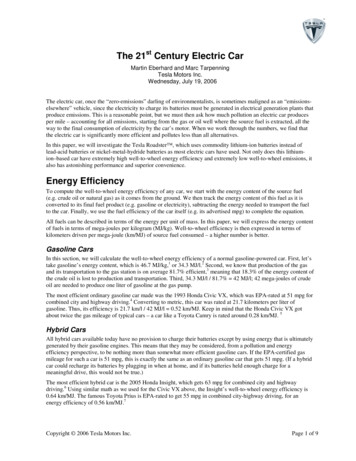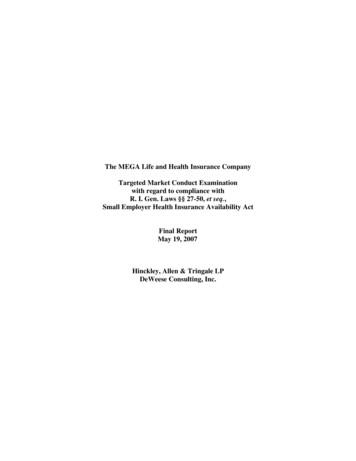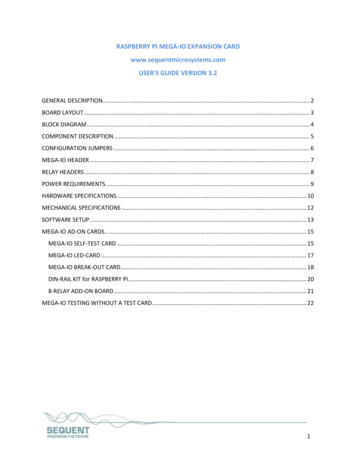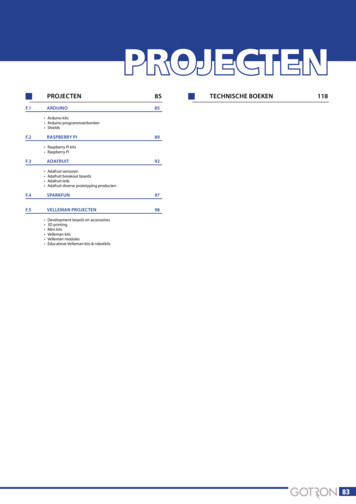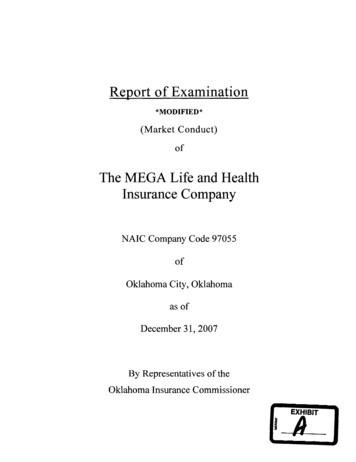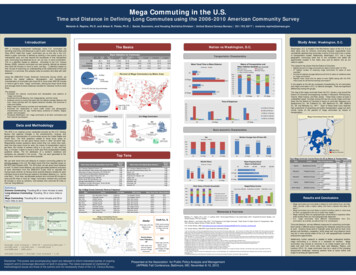
Transcription
Mega Commuting in the U.S.Time and Distance in Defining Long Commutes using the 2006-2010 American Community SurveyMelanie A. Rapino, Ph.D. and Alison K. Fields, Ph.D. Social, Economic, and Housing Statistics Division United States Census Bureau 301.763.5877 melanie.rapino@census.govStudy Area: Washington, D.C.IntroductionWith a changing employment landscape, some U.S. commuters aretravelling long times and distances to get to work. One study by Moss andQing (2012) noted that “super” commuters are on the rise in the U.S.where a super commuter is defined as working in the central county of ametropolitan area, but lives beyond the boundaries of that metropolitanarea, commuting long distances by air, rail, car, bus, or some combination.This is a definition based on distance. According to the U.S. CensusBureau (2005), extreme commuters are also growing, defined as workerswho travel 90 minutes or more to work, one-way – a definition based ontime. As part of improving our understanding of the relationship of time anddistance in a commute, this analysis looks at workers who deal with bothextremes.Using the 2006-2010 5-year American Community Survey (ACS), weexamine the spatial patterns, demographic, and transportationcharacteristics of commuters who travel 50 or more miles AND 90 minutesor more to get to work, “mega” commuters, utilizing the mean travel timesand average block-to-block distances traveled for individual home-to-workflows.The BasicsNation vs Washington, D.C.Basic Statistics for CommutesMean TravelTime (in %95%MeanDistanceNo. of Commuters(in thousands)18.870.9247.3166.4% DroveAlone71,2031,7142,242587% PublicTransportation81.959.075.968.3% Carpool5.025.34.911.3% Nonwhite9.511.813.314.3Transportation Characteristics% Hispanic22.427.418.119.012.912.811.110.4Mean Travel Time vs Mean DistanceMinutesMeans of Transportation andMean Vehicles Available (per household)MilesDrove alonePublic TransportationMean Vehicles Available26.1USPercent of Mega Commuters by Metro AreaOther18.8This research has shown that the District of ColumbiaCarpooledOther means3100%90%166.42.42.280%119.0US MegaLongCommutesWashington, D.C. is located in the Mid-Atlantic region of the U.S. It is anideal study area for extreme commuting because respondents haveconsistently reported long commutes in terms of time and it has a varietyof transportation modes. Additionally, Washington, D.C. has a largegeographic commuting shed due to the consistent and stable jobopportunities located in the metro area and its distinct role as ournation’s capital.2.32.51.870%2 Highest percent of mega commuters for place of work state7 (2.15%) 4th highest number of receiving mega commuters for place of workcounties8 Among the highest average distance and time for place of residence statefor mega commuters9 Highest mean travel time for place of work CBSA (along with the NYCmetro area) for all full-time working commuters1060%50%42.5DCOf the 5% that are long commutes:1.540%26.3130%20%The analysis118.6DC Mega Evaluates the national, county-level and metropolitan area patterns of“mega” commuting Examines time and distance, first, independently, and then jointly Analyzes county-to-county flow pairs with the highest average distance andtime; noting counties with the highest distance traveled, and extremes ininflow and outflow. Maps mega commutes by counties and metropolitan areas Examines the relationship to travel mode choice and demographiccharacteristics such as, age, marital status, presence of children, wages,gender, and occupation Compares Washington, DC, mega commuters to all other commuters andtheir national counterparts .10%102.60%0USUS MegaDCDC MegaTime of Departure80%Less than 0.5%0.5 - 1.49%1.5 - 2.95%In the graphs to the left we compared characteristics for all commutersand mega commuters in D.C. to national averages. There are significantdifferences among the groups.0.570%60%12:00 to 5:59 am50%6:00 to 8:59 am40%30%9:00 to 11:59 am20%12:00 to 3:59 pm10%The map of the mega commuter flows into D.C. shows a ring around theDistrict of Columbia encompassing counties in Maryland, Pennsylvania,Virginia, West Virginia, and New Jersey. These flows contain at least 3unweighted cases. Counties among the top five county mega commuterflows into the District of Columbia in terms of commuter frequency are:Spotsylvania Co., VA, Frederick Co., MD, Baltimore Co., MD, StaffordCo, VA, and Berkeley Co., WV.11 Each of these flows have relativelyhigh proportions of carpooling and public transportation usage but eachcounty varies on the percent of mega commuters by means oftransportation.Mega Commuting Flows into DC4:00 to 11:59 pm0%USUS MegaDCDC MegaData and MethodologySocio-economic CharacteristicsThe ACS is an ongoing survey conducted annually by the U.S. CensusBureau that captures changes in the socioeconomic, housing, anddemographic characteristics of communities across the United States andPuerto Rico. The ACS questions related to travel focus solely oncommuting and do not ask about leisure travel or other non-work trips.Respondents answer questions about where they live, where they work,what time they leave home for work, the means of transportation used toget there, the number of workers riding in a car, truck, or van, and howlong, in minutes, it takes to travel to work (see ACS transportation-relatedquestions below). The full addresses of a worker’s residence andworkplace are collected in the survey. They are each geocoded to theplace-level, and the block-level where possible.SexFemaleWorkers Younger than 30 Years Old18.1%Male16.1%100%80%10.6%9.1%60%40%Mega Flows20%Top TensDistrict of Columbia0%USUS MegaDCDC MegaUSUS MegaDCDC MegaTop 5 Mega Commuter County Flows into DC by Means of TransportationWe use both travel time and distance to analyze commuting patterns forfull-time workers in the U.S. We obtain travel time from reported values onthe ACS (see Question #33). The ACS does not ask about travel distanceto work. To obtain travel distance, we utilize geocoded residence and placeof work information from the 2006-2010 5-year ACS to calculate theCensus block centroid -to-Census block centroid distance variable for eachindividual home-to-work flow pair based on Euclidean distance (i.e., “as thecrow flies”). From here, we delineate workers who commute 90 minutes ormore and 50 miles or more as “mega” commuters, workers who commute90 minutes or more as “extreme,” and workers who commute 50 miles ormore as “long-distance.”DefinitionsExtreme Commuting: Traveling 90 or more minutes to work.Long-distance Commuting: Traveling 50 or more miles towork.Mega Commuting: Traveling 90 or more minutes and 50 ormore miles to work.Metro Areas with the Highest Mean Travel Time1San Francisco-Oakland-Fremont, CANew York-Northern New Jersey-Long Island, NY-NJ-PAWashington-Arlington-Alexandria, DC-VA-MD-WVTrenton-Ewing NJ Metropolitan Statistical AreaLos Angeles-Long Beach-Santa Ana, CABoston-Cambridge-Quincy, MA-NHAtlanta-Sandy Springs-Marietta, GAChicago-Joliet-Naperville, IL-IN-WIPhiladelphia-Camden-Wilmington, PA-NJ-DE-MDSeattle-Tacoma-Bellevue, .810.800.57Metro Areas with Highest Mean Distance2San Francisco-Oakland-Fremont, CASan Jose-Sunnyvale-Santa Clara, CASalinas, CAGulfport-Biloxi, MSHinesville-Fort Stewart, GALawton, OKFayetteville, NCBrunswick, GAAnchorage, AKHonolulu, ntySan Bernardino CountyRiverside CountySuffolk CountyFairfield CountyOrange CountyMercer CountyRiverside CountyDutchess CountySan Joaquin CountyMonroe CountyPOW StateCaliforniaCaliforniaNew YorkNew YorkNew YorkNew YorkCaliforniaNew YorkCaliforniaNew YorkPOW CountyMean Travel Time Mean DistanceLos Angeles CountyLos Angeles CountyNew York CountyNew York CountyNew York CountyNew York CountySan Diego CountyNew York CountyAlameda CountyNew York 1120.5Alaska4POW state with thehighest ight Line Distance 3949.99 * arcos(sin(LAT res) *sin(LAT mig) cos(LAT res) * cos(LAT mig) *cos(LONG mig - LONG res))Inflated Distance Straight Line Distance * 1.25Disclaimer: This poster and accompanying report are released to inform interested parties of ongoingresearch and to encourage discussion of work in progress. The views expressed on statistical ormethodological issues are those of the authors and not necessarily those of the U.S. Census Bureau.Married74.4%71.6%60.3%53.0%39.7% 0POW metro areawith the highestpercent of 91.1Cook Co., ILPOW county amongthe highest numberof mega receivingflows.DC6POW state with thehighest meantravel time &percentage of megacommuters. 20,000US47.0%28.4%25.6% 40,000 60,000US MegaDCDC Mega 80,000Virginia 41,298.32MarylandUS Mega 50,184.62DCUSStateMean Property Value/Mean # of BedroomsOther 71,522.62DC MegaMaryland 58,967.46VirginiaWork Status of Family HouseholdsWages/Salary Income100%Top 10 Mega County Commuter Flows by Frequency3CaliforniaCaliforniaNew YorkConnecticutNew YorkNew JerseyCaliforniaNew YorkCaliforniaPennsylvaniaMarital StatusPercentMegaCommutesLess than 40,00080% 40,000 to 79,999West Virginia 80,000 or moreCountyMode of TransportationDrove aloneSpotsylvania County CarpooledPublic TransportationDrove aloneFrederick County CarpooledPublic TransportationDrove aloneBaltimore County CarpooledPublic TransportationDrove aloneCarpooledStafford CountyPublic TransportationDrove aloneCarpooledBerkeley CountyPublic 8.515.827.114.09.239.673.7100.0100.0Percent ofMode .935.910.353.860%60%40%No spouse present50%Spouse does not work40%Spouse works part‐timeSpouse works full‐time20%0%Results and Conclusions30%20%10%0%USUS MegaDCDC MegaUSUS MegaDCDC MegaReferences & FootnotesMateyka, P. J., Rapino, M. A., and L. C. Landivar, 2012. “Home-based Workers in the United States: 2010,” Household Economic Studies, U.S.Census Bureau, P70-132, October.Moss, Mitchell L. and Carson Qing, 2012. “The Emergence of the Super-Commuter,” Rudin Center for Rudin Center for Transportation, NewYork University Wagner School of Public Service, February.U.S. Census Bureau. 2005 03-30 Commute extremes.pdfU.S. Census Bureau. 2006-2010 5-year American Community Survey.1 Not all metro areas on this list have statistically different mean travel times from those ranked lower. San Francisco, CA, Boston, MA. and, Seattle, WA metro areas have percentmega commuters that are statistically different from all other metro areas on the list at the 90 percent confidence level but not necessarily from metro areas excluded from the list.2 Anchorage, AK and Honolulu, HI have statistically different mean distances from other metro areas at the 90 percent confidence level, but not from each other. None of the metroareas on the list have percent mega commuters that is statistically different from all other metro areas on the list.3 San Bernadino Co., CA to Los Angeles Co., CA and Fairfield Co., CT to New York Co., NY have commuter flow counts that are statistically different at the 90 percent confidencelevel. The flow from San Bernadino Co., CA to Los Angeles Co., CA has a mean travel time that is statistically different from the next flow and a mean distance that is statisticallydifferent from the other flows in the table at the 90 percent confidence level.4 Alaska as a POW state has the statistically highest mean distance, except for Hawaii, at the 90 percent confidence level.5 Statistically different from other POW metro areas by percent mega commuters, except Santa Fe, NM metro area, at the 90 percent confidence level.6 Statistically different from other place of work states for mean travel time and percentage of mega commuters at the 90 percent confidence level.7 Statistically different from other place of work states at the 90 percent confidence level.8 Statistically different from other place of work counties at the 90 percent confidence level.9 Not statistically different from all other place of residence states for mega commuters.10 Statistically different from other place of work CBSAs at the 90 percent confidence limit, except for the New York-New York-Northern New Jersey-Long Island, NY-NJ-PAmetropolitan statistical area.11 The number of mega commuters from Spotsylvania County, VA into Washington, DC is statistically different at the 90 percent confidence level from other county flows intoWashington, DC.12 Statistically significant at the 90 percent confidence level for full-time commuting US workers versus their mega counterparts.Presented at the Association for Public Policy Analysis and Management(APPAM) Fall Conference, Baltimore, MD, November 8-10, 2012. Mega commuters are more likely to depart for work before 6 am, be male,older, married, make a higher salary, and have a spouse that does notwork.12 Mega commuters are more likely to travel to another metro or micro areafor work, as opposed to the one in which they reside.12 Mega receiving flows are geographically concentrated in populous cities,while sending flows are more geographically dispersed. D.C. mega commuters have different characteristics from D.C.commuters as a whole, as well as their U.S. counterparts.Time and distance are two different measures for examining commutes.Each paints a different picture regarding the obstacles along the journeyto work. Extreme times tend to highlight areas that tend to have moredensity and therefore, congestion, while areas with long distance travelmay be in more remote areas of the U.S. with geographically clusteredemployment opportunities.Additionally, further research is needed to better understand whethermega commuting is a choice or a necessity for workers. Megacommuters may choose to commute to an onsite location part of theweek and work from home other days (see Mateyka, Rapino, andLandivar 2012). Or, mega commuters may be a result of the changingemployment landscape, meaning workers have to travel further andlonger to existing job opportunities.
Mega Commuters in the U.S.Time and Distance in Defining the Long Commute using theAmerican Community SurveyMelanie A. Rapino, Ph.D.Alison K. Fields, Ph.D.Journey to Work and Migration Statistics BranchSocial, Economic, and Housing Statistics DivisionUnited States Census BureauWorking Paper 2013-03Presented at theAssociation for Public Policy Analysis and Management Fall 2013 ConferenceDisclaimer: This paper is released to inform interested parties of ongoing research and toencourage discussion of work in progress. The views expressed on statistical or methodologicalissues are those of the authors and not necessarily those of the U.S. Census Bureau.
Mega Commuters in the U.S.: Time and Distance in Defining the Long Commute usingthe American Community SurveyMelanie A. Rapino, Ph.D.Alison K. Fields, Ph.D.Journey to Work and Migration Statistics BranchSocial, Economic, and Housing Statistics BranchUnited States Census BureauIntroductionWith a changing employment landscape, some U.S. commuters are travelling long times anddistances to get to work. One study by Moss and Qing (2012) noted that “super” commuters areon the rise in the U.S. In their analysis, a super commuter is defined as working in the centralcounty of a metropolitan area, but lives beyond the boundaries of that metropolitan area,commuting long distances by air, rail, car, bus, or some combination. This is a definition basedon distance. Extreme commuting has been increasing since at least 1990 (see Figure 1).Extreme commuters are defined as workers who travel 90 minutes or more to work, one-way –a definition based on time (U.S. Census Bureau, 2005). Additionally, this research defines longdistance commuters as workers who travel 50 miles or more to work, one-way. And megacommuters as those who combine these two definitions and travel 90 minutes or more and 50miles or more to work, one-way.DefinitionsExtreme Commuting: Traveling 90 or more minutes to work.Long-distance Commuting: Traveling 50 or more miles to work.Mega Commuting: Traveling 90 or more minutes and 50 or more miles to work.This analysis evaluates the national, county-level, and metropolitan area patterns of “mega”commuting, examining time and distance, first, independently, and then jointly. We analyzecommutes determining the county-to-county flow pairs with the highest average distance andtime; noting counties with the highest distance traveled, and extremes in inflow and outflow. Wemapped the mega commutes by counties and metropolitan areas and examine these measuresin relationship to travel mode choice, in the presence of demographic characteristics such as,age, marital status, presence of children, wages, gender, and occupation. Additionally, using thestudy area of Washington, D.C., we compare mega commuters to other commuters and theirnational counterparts. Washingtonian commuters report some of the longest commute times inthe U.S. and have a variety of transportation modes from which to choose. These results willbetter inform how to define these commutes with respect to both time and distance.1
Figure1: Percent of Workers with Commute Times of 90 Minutes or More, 1990-2011Percent of Workers with Commute Times of90 Minutes or us2006 2007 2008 2009 2010 2011ACS ACS ACS ACS ACS ACSSource: U.S. Census Bureau, 1990 Census, Census 2000, 2006 ACS, 2007, 2008 ACS, 2009 ACS, 2010ACS, 2011 ACS.Research Questions What are the geographic patterns and distribution of mega commuters? What are the transportation and socio-economic characteristics of mega commuters incomparison to other commuters? How do commuters into the District of Columbia compare to commuters across theU.S.?Data and MethodologyThe American Community Survey (ACS) is a nationwide survey designed to providecommunities with reliable and timely demographic, social, economic, and housing data for thenation, states, congressional districts, counties, places, and other localities every year. It had a2011 sample size of about 3.3 million addresses across the United States and Puerto Rico andincludes both housing units and group quarters (e.g.,nursing facilities and prisons). The ACS isconducted in every county throughout the nation and every municipio in Puerto Rico, where it iscalled the Puerto Rico Community Survey. Beginning in 2006, ACS data for 2005 were releasedfor geographic areas with populations of 65,000 and greater. For information on the ACSsample design and other topics, visit www.census.gov/acs/www .This research utilizes the 2006-2010 5-year ACS. The 5-year ACS estimates contain 60months of collected data, which allows for a larger sample size and more reliable, precise, butless current, estimates than the 1-year and 3-year datasets. For this research, the 5-yeardataset was advantageous to examine such a small sect of the population at geographies belowthe national or state level.The ACS questions related to daily travel patterns focus solely on commuting and do not askabout leisure travel or other non-work trips. Respondents answer questions about where theylive, where they work, what time they leave home for work, the means of transportation used to2
get there, the number of workers riding in a car, truck, or van, and how long, in minutes, it takesto travel to work (see ACS transportation-related questions on associated poster). The fulladdresses of a worker’s residence and workplace are collected in the survey. They are eachgeocoded to the place-level, and the block-level where possible.We use both travel time and distance to analyze commuting patterns for full-time workers in theU.S., where full-time workers have been defined as those who reported working 50 or moreweeks a year and 35 or more hours per week. We obtain travel time from reported values onthe ACS (see Question #33). The ACS does not ask about travel distance to work. To estimatetravel distance, we utilize geocoded residence and place of work information from the 20062010 5-year ACS to calculate the Census block centroid -to-Census block centroid distancevariable for each individual home-to-work flow pair based on Euclidean distance (i.e., “as thecrow flies”) (see Equation 1). In order to account for the transportation network effect, the traveldistance obtained from Equation 1 is multiplied by a constant of 1.25 (see Equation 2).From here, we delineate workers who commute 90 minutes or more and 50 miles or more as“mega” commuters, workers who commute 90 minutes or more as “extreme,” and workers whocommute 50 miles or more as “long-distance” (see Definitions box above).Equation 1Straight Line Distance 3949.99 * arcos(sin(LAT res) * sin(LAT pow) cos(LAT res) *cos(LAT pow) * cos(LONG pow - LONG res))where, LAT res is the latitude of the centroid of the residential block of each commuter, LAT pow isthe latitude of the centroid of the place of work census block of each commuter, LONG res is thelongitude of the centroid of the place of residence of each commuter, and LONG pow is the longitudeof the centroid of the place of work of each commuter.Equation 2Inflated Distance Straight Line Distance * 1.25where, Straight Line Distance is defined in Equation 1 and 1.25 is a constant (Sparks et al., 2011).Findings and DiscussionOf all reported commutes in the U.S. for full-time workers, approximately 5% are considered tobe “long”, while 95% make up other commutes. Of the long commutes, about 2.41% or1,713,931 can be categorized as extreme, 3.15% or 2,241,915 as long-distance, and 0.82% or586,805 as mega.This research has shown that in the U.S.:oMega commuters are more likely to depart for work before 6 am, be male, older,married, make a higher salary, and have a spouse that does not work (see AppendixTable 1).11Statistically significant at the 90 percent confidence level for full-time working U.S. commuters versustheir mega counterparts.3
ooMega commuters are more likely to travel to another metro or micro area for work, asopposed to the one in which they reside.2Mega receiving flows are geographically concentrated in populous cities, while sendingflows are more geographically dispersed (see ‘Mega Commuting Flows: Top Sendingand Receiving Counties’ map).Table 1: Percent Mega Commutes for Metro Areas with the Highest Mean Travel Time for Fulltime Working Commuters3Metro Areas with the Highest Mean Travel TimeSan Francisco-Oakland-Fremont, CANew York-Northern New Jersey-Long Island, NY-NJ-PAWashington-Arlington-Alexandria, DC-VA-MD-WVTrenton-Ewing NJ Metropolitan Statistical AreaLos Angeles-Long Beach-Santa Ana, CABoston-Cambridge-Quincy, MA-NHAtlanta-Sandy Springs-Marietta, GAChicago-Joliet-Naperville, IL-IN-WIPhiladelphia-Camden-Wilmington, PA-NJ-DE-MDSeattle-Tacoma-Bellevue, WAPercent 57Table 2: Percent Mega Commutes for Metro Areas with the Highest Mean Distance for Full-timeWorking Commuters4Metro Areas with Highest Mean DistanceSan Francisco-Oakland-Fremont, CASan Jose-Sunnyvale-Santa Clara, CASalinas, CAGulfport-Biloxi, MSHinesville-Fort Stewart, GALawton, OKFayetteville, NCBrunswick, GAAnchorage, AKHonolulu, HIPercent 082Statistically significant at the 90 percent confidence level for full-time working U.S. commuters versustheir mega counterparts.3Not all metro areas on this list have statistically different mean travel times from those ranked lower.San Francisco, CA, Boston, MA. and, Seattle, WA metro areas have percent mega commuters that arestatistically different from all other metro areas on the list at the 90 percent confidence level but notnecessarily from metro areas excluded from the list.4Anchorage, AK and Honolulu, HI have statistically different mean distances from other metro areas atthe 90 percent confidence level, but not from each other. None of the metro areas on the list have percentmega commuters that is statistically different from all other metro areas on the list.4
Geographic DispersionsThe map of the percent of mega commuters by metro area shows a dispersion across the U.S.with the biggest clusters located in major metro areas on the east and west coasts such as NewYork, NY, Washington, D.C., San Francisco, CA, and Los Angeles, CA. Interestingly, there aretwo additional clusters in the New Orleans, LA and Houma, LA areas as well as the Santa Fe,NM and Farmington, NM. Included in the Appendix is a tabulation of place of work metropolitanstatistical areas with the estimated number of mega commuters, estimated margin of error,percent of mega commuters, and percent margin of error (see Appendix Table 2).Of note,o San Bernadino Co., CA to Los Angeles Co., CA and Fairfield Co., CT to New York Co.,NY flows have flow counts that are statistically larger than other mega commuter flows atthe 90 percent confidence level (see Table 3).oThe flow from San Bernadino Co., CA to Los Angeles Co., CA has a mean travel timeand mean distance that is statistically larger than other mega commuter flows at the 90percent confidence level (see Table 3).Table 3: Mean Travel Time and Mean Distance for the Most Frequent Mega Commuter FlowsTop 10 Mega County Commuter Flows by FrequencyStateCountyPOW State POW CountyCaliforniaCaliforniaNew YorkConnecticutNew YorkNew JerseyCaliforniaNew YorkCaliforniaPennsylvaniaSan Bernardino CountyRiverside CountySuffolk CountyFairfield CountyOrange CountyMercer CountyRiverside CountyDutchess CountySan Joaquin CountyMonroe CountyCaliforniaCaliforniaNew YorkNew YorkNew YorkNew YorkCaliforniaNew YorkCaliforniaNew YorkLos Angeles CountyLos Angeles CountyNew York CountyNew York CountyNew York CountyNew York CountySan Diego CountyNew York CountyAlameda CountyNew York CountyMean 76.361.591.15
Focus: Washington, D.C.Washington, D.C. is located in the Mid-Atlantic region of the U.S. It is an ideal area to furtherexamine long commuting patterns because respondents have consistently reported longcommutes in terms of time and it has a variety of transportation modes. According to a U.S.Census Bureau report, more than a quarter (27.4 percent) of District of Columbia workerstraveled 60 minutes or longer to get to work, notably higher than that of any other state(McKenzie 2013). Additionally, Washington, D.C. has a large geographic commuting shed dueto the consistent and stable job opportunities located in the metro area and its distinct role asour nation’s capital.This research has shown that in the District of Columbia:o D.C. mega commuters have different characteristics from D.C. commuters as a whole,as well as their U.S. counterparts.o In terms of place of work state, the highest percent of mega commuters work in D.C.5(2.15%)o In terms of place of work county, D.C. has the 4th highest number of receiving megacommuters.6o For place of residence state, D.C. mega commuters have among the highest averagedistance and time.7o Highest mean travel time for place of work CBSA (along with the NYC metro area) for allfull-time working commuters.8The map of the mega commuter flows into D.C. shows a ring around the District of Columbiaencompassing counties in Maryland, Pennsylvania, Virginia, West Virginia, and New Jersey.These flows contain at least 3 unweighted cases. Counties among the top five county megacommuter flows into the District of Columbia in terms of commuter frequency are: SpotsylvaniaCo., VA, Frederick Co., MD, Baltimore Co., MD, Stafford Co, VA, and Berkeley Co., WV (seeTable 4).9 Each of these flows have relatively high proportions of carpooling and publictransportation usage but each county varies on the percent of mega commuters by means oftransportation.5Statistically different from other place of work states at the 90 percent confidence level.6Statistically different from other place of work counties at the 90 percent confidence level.7Not statistically different from all other place of residence states for mega commuters.8Statistically different from other place of work CBSAs at the 90 percent confidence limit, except for theNew York-New York-Northern New Jersey-Long Island, NY-NJ-PA metropolitan statistical area.9The number of mega commuters from Spotsylvania County, VA into Washington, DC is statisticallydifferent at the 90 percent confidence level from other county flows into Washington, DC.6
Table 4: Percent Mega Commuters and Percent of Mode Share for the Most Frequent MegaCommuter Flows into Washington, D.C. by CountyTop 5 Mega Commuter County Flows into DC by Means of TransportationStateCountyVirginiaSpotsylvania CountyMarylandFrederick CountyMarylandBaltimore CountyVirginiaStafford CountyWest VirginiaBerkeley CountyMode of TransportationDrove aloneCarpooledPublic TransportationDrove aloneCarpooledPublic TransportationDrove aloneCarpooledPublic TransportationDrove aloneCarpooledPublic TransportationDrove aloneCarpooledPublic TransportationPercentMegaPercent ofMode 032.724.542.935.910.353.8Concluding ThoughtsFurther research is needed to better understand whether mega commuting is a choice or anecessity for workers. Mega commuters may choose to commute to an onsite location part ofthe week and work from home other days (see Mateyka, Rapino, and Landivar 2012). Or, megacommuters may be a result of the changing employment landscape, meaning workers have totravel further and longer to existing job opportunities.7
ReferencesMateyka, P. J., Rapino, M. A., and L. C. Landivar, 2012. “Home-based Workers in the UnitedStates: 2010,” Household Economic Studies, U.S. Census Burea
opportunities located in the metro area and its distinct role as our nation's capital. This research has shown that the District of Columbia Highest percent of mega commuters for place of work state7 (2.15%) 4th highest number of receiving mega commuters for place of work counties8
